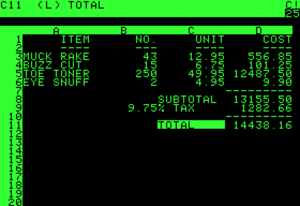VisiCalc
 |
|

An example VisiCalc spreadsheet on an Apple II
|
|
| Developer(s) | Software Arts |
|---|---|
| Initial release | 1979 |
| Stable release |
VisiCalc Advanced Version / 1983
|
| Operating system | Apple II, Apple SOS, CP/M, Atari 8-bit family, Commodore PET, TRSDOS, Sony SMC-70, DOS, HP series 80 |
| Type | Spreadsheet |
| License | Commercial proprietary software |
| Website | danbricklin |
VisiCalc (for "visible calculator") was the first spreadsheet computer program for personal computers, originally released for the Apple II by VisiCorp. It is often considered the application that turned the microcomputer from a hobby for computer enthusiasts into a serious business tool, prompting IBM to introduce the IBM PC two years later. VisiCalc is considered the Apple II's killer app. It sold over 700,000 copies in six years, and as many as 1 million copies over its history.
Initially developed in a 6502 assembler running on the Multics time sharing system, VisiCalc was ported to numerous platforms, both 8-bit and some of the early 16-bit systems. In order to do this, the company developed porting platforms that produced bug compatible versions. The company took the same approach when the IBM PC was launched, producing a product that was essentially identical to the original 8-bit Apple II version. Sales were initially brisk, with about 300,000 copies sold.
VisiCalc used the A1 notation in formulas.
When Lotus 1-2-3 was launched in 1983, taking full advantage of the expanded memory and screen of the PC, VisiCalc sales practically ended overnight. Sales imploded so rapidly that the company was soon insolvent. Lotus Development purchased the company in 1985, and immediately ended sales of VisiCalc and the company's other products.
VISICALC represented a new idea of a way to use a computer and a new way of thinking about the world. Where conventional programming was thought of as a sequence of steps, this new thing was no longer sequential in effect: When you made a change in one place, all other things changed instantly and automatically.
VisiCalc traces its history to a presentation that Dan Bricklin was watching while attending Harvard Business School. The professor was creating a financial model on a blackboard that was ruled with lines to create a table, and formulas and data were being written into the cells. When the professor found an error or wanted to change a parameter, he had to erase and rewrite a number of sequential entries in the table. Bricklin realized that he could replicate the process on a computer using an "electronic spreadsheet" to view results of underlying formulae.
...
Wikipedia
